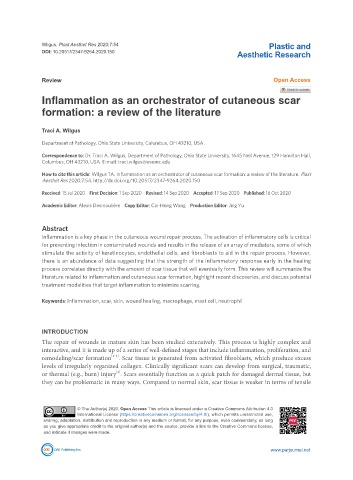Page 622 - Read Online
P. 622
Wilgus. Plast Aesthet Res 2020;7:54 Plastic and
DOI: 10.20517/2347-9264.2020.150 Aesthetic Research
Review Open Access
Inflammation as an orchestrator of cutaneous scar
formation: a review of the literature
Traci A. Wilgus
Department of Pathology, Ohio State University, Columbus, OH 43210, USA.
Correspondence to: Dr. Traci A. Wilgus, Department of Pathology, Ohio State University, 1645 Neil Avenue, 129 Hamilton Hall,
Columbus, OH 43210, USA. E-mail: traci.wilgus@osumc.edu
How to cite this article: Wilgus TA. Inflammation as an orchestrator of cutaneous scar formation: a review of the literature. Plast
Aesthet Res 2020;7:54. http://dx.doi.org/10.20517/2347-9264.2020.150
Received: 15 Jul 2020 First Decision: 1 Sep 2020 Revised: 14 Sep 2020 Accepted: 17 Sep 2020 Published: 16 Oct 2020
Academic Editor: Alexis Desmoulière Copy Editor: Cai-Hong Wang Production Editor: Jing Yu
Abstract
Inflammation is a key phase in the cutaneous wound repair process. The activation of inflammatory cells is critical
for preventing infection in contaminated wounds and results in the release of an array of mediators, some of which
stimulate the activity of keratinocytes, endothelial cells, and fibroblasts to aid in the repair process. However,
there is an abundance of data suggesting that the strength of the inflammatory response early in the healing
process correlates directly with the amount of scar tissue that will eventually form. This review will summarize the
literature related to inflammation and cutaneous scar formation, highlight recent discoveries, and discuss potential
treatment modalities that target inflammation to minimize scarring.
Keywords: Inflammation, scar, skin, wound healing, macrophage, mast cell, neutrophil
INTRODUCTION
The repair of wounds in mature skin has been studied extensively. This process is highly complex and
interactive, and it is made up of a series of well-defined stages that include inflammation, proliferation, and
[1-3]
remodeling/scar formation . Scar tissue is generated from activated fibroblasts, which produce excess
levels of irregularly organized collagen. Clinically significant scars can develop from surgical, traumatic,
[4]
or thermal (e.g., burn) injury . Scars essentially function as a quick patch for damaged dermal tissue, but
they can be problematic in many ways. Compared to normal skin, scar tissue is weaker in terms of tensile
© The Author(s) 2020. Open Access This article is licensed under a Creative Commons Attribution 4.0
International License (https://creativecommons.org/licenses/by/4.0/), which permits unrestricted use,
sharing, adaptation, distribution and reproduction in any medium or format, for any purpose, even commercially, as long
as you give appropriate credit to the original author(s) and the source, provide a link to the Creative Commons license,
and indicate if changes were made.
www.parjournal.net

